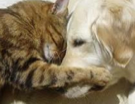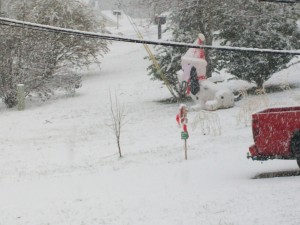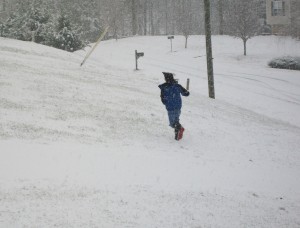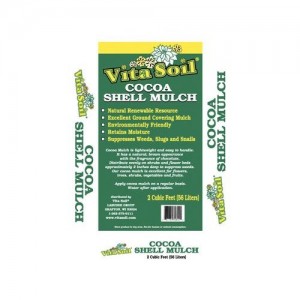Archive for the ‘Pet Safety’ Category
On Thursday, November 18th, the last meeting of 2010 of the Georgia Network of Professional Pet Sitters (GNPP) had us celebrating the year in retrospect, sharing some great snacks, and thanking the outgoing Board Members Mike Howell of Two Dads Pet Services (former Vice President, coming back in 2011 as President) and Eindy Ramsey of The Pet Shepherd (outgoing President and incoming 2011 Marketing Director) for their work in the past year.
Outgoing Vice President and President
In keeping with the “pet†theme, Eindy was presented with a “Litter Box Cake†for all her hard work as President.
Doesn’t this look realistic?
This warning about the potential danger to pets posed by cocoa mulch began appearing in 2001. Unlike the majority of scary alerts spread through the Internet, there is at least some truth to this one, although we know of only one substantiated case of a pet death caused by ingestion of the substance. (In July 2007, “Moose,” a 3-year-old Labrador belonging to a Minneapolis couple, died after eating cocoa mulch purchased at a local store. His owners had a veterinarian at the University of Minnesota perform a necropsy to determine the likely cause of death of their young and previously healthy pet. The vet found cocoa shells in Moose’s stomach and evidence of theobromine in the shells.)
Veterinarians have noted that cocoa mulch contains ingredients that could pose a health risk to dogs (and other pets that might be tempted to ingest it):
“Cocoa mulch is a risk, especially to dogs,” said Dr. Larry Family of Aqueduct Animal Hospital.
Found in most home garden centers, cocoa mulch is known for its fine texture and the sweet smell the fresh mulch gives off. But getting past the scent, Family says cocoa mulch can be dangerous if a dog starts eating it. It contains two key ingredients found in chocolate: theobromine and caffeine. Similar to eating chocolate, he says a dog that eats just a few ounces of cocoa mulch could starting having stomach problems and it could get worse if it eats more.
“As time goes on they might act restless, excited, it can produce tremors and seriously seizures,” Family explained.
“Puppies are very curious animals. So they’re going to be attracted to various things around the yard and [the effect of eating cocoa mulch] seems to be more severe in the small breeds, and it depends on the amount they actually ingest,” Family said.
The American Society for the Prevention of Cruelty to Animals (ASPCA) confirms the potential effects of theobromine and caffeine on dogs:
Cocoa beans contain the stimulants caffeine and theobromine. Dogs are highly sensitive to these chemicals, called methylxanthines. In dogs, low doses of methylxanthine can cause mild gastrointestinal upset (vomiting, diarrhea, and/or abdominal pain); higher doses can cause rapid heart rate, muscle tremors, seizures, and death.
Eaten by a 50-pound dog, about 2 ounces of cocoa bean mulch may cause gastrointestinal upset; about 4.5 ounces,increased heart rate; about 5.3 ounces, seizures; and over 9 ounces, death. (In contrast, a 50-pound dog can eat up to about 7.5 ounces of milk chocolate without gastrointestinal upset and up to about a pound of milk chocolate without increased heart rate.)
According to (“http://petcare.umn.edu/FAQ/Toxicology/Chocolate.htm“) tables we’ve examined, cocoa mulch contains 300-1200 mg. of theobromine per ounce, making cocoa mulch one of the strongest concentrations of theobromine a pet is likely to encounter in any chocolate product.  However, the question of the gravity of the risk presented by this type of gardening mulch remains a matter of debate. According to Hershey’s, for example:
It is true that studies have shown that 50% of the dogs that eat Cocoa Mulch can suffer physical harm to a variety of degrees (depending on each individual dog). However, 98% of all dogs won’t eat it.
And some of those who vend cocoa mulch note that although they’re aware of the pet warnings, they’ve never encountered a case of a dog’s being sickened by the product:
“The weird thing is, it smells like a chocolate Pop Tart. That’s the best way I can describe it. It really does have a chocolate scent to it,” explained Shane Compton of Hewitt’s Garden Center.
Compton says cocoa mulch is not that popular at his store, but says it has its regular customers who every now and then wonder about the rumors they hear and the effect it has on man’s best friend.
“There’s always stories on the Internet, but in the 30 years we’ve been here we’ve actually never heard of any body’s dog getting sick,” Compton said.
Some manufacturers of cocoa mulch (such as the Cocoa Mulch brand) now proclaim that their products are theobromine-free and pet safe. Responsible pet owners should take care in their selection of cocoa mulch brands; some might prefer to choose another form of soil enhancement for their gardens, such as cedar-based products, rather than gamble their dogs won’t be attracted to or harmed by cocoa mulch.
(Although Home Depot is named as a vendor of cocoa mulch in the example cited at the head of this page, the company told us in May 2006 that: “The Home Depot does not and will not sell mulch harmful to pets. The mulch sold by The Home Depot containing cocoa shells goes through several cleaning processes, including a high heat system in order to strip the cocoa fat from the shells without the use of any chemicals.”)
The danger of canine theobromine poisoning does not begin and end with cocoa mulch, however: chocolate in any form poses substantial risks to some pets. This most beloved of foodstuffs contains theobromine and small amounts of caffeine, both of which can sicken and even kill cats and dogs.
Chocolate’s toxicity to animals is directly related to three factors: the type of chocolate, the size of the animal, and the amount of chocolate ingested. Unsweetened baking chocolate presents the greatest danger to pets because it contains the highest amount of theobromine, approximately 390-450 mg. per ounce. White chocolate contains the least. As a general rule of thumb, one ounce of milk chocolate per pound of body weight can be lethal for dogs and cats. (Milk chocolate contains approximately 44-66 mg of theobromine per ounce.)
Theobromine affects the heart, central nervous system, and kidneys, causing nausea and vomiting, restlessness, diarrhea, muscle tremors, and increased urination. Cardiac arrhythmia and seizures are symptoms of more advanced poisoning. Other than induced vomiting, vets have no treatment or antidote for theobromine poisoning. Death can occur in 12 to 24 hours.
This type of poisoning is uncommon because it is rare that a dog, even a small dog, will eat enough chocolate to cause anything more than an upset stomach. Yet it can happen, especially if the animal gets into baking chocolate or powdered cocoa, two forms of the sweet particularly loaded with theobromine.
Do not feed chocolate to dogs or cats. If you keep a pet, do not leave chocolate lying about lest your critter help himself to it and in so doing poison himself. If your animal begins exhibiting signs of distress and you believe he might have gotten into some chocolate, call your veterinarian immediately. (It will help if you can supply information about the approximate weight of your critter, what sort of chocolate was ingested; white, milk, dark, cocoa powder, baking; and roughly how much.) But time is of the essence if such a poisoning has indeed taken place, so make the call right away.
Most of us love cute little puppies and kittens. And often we find ones that seem homeless that we want to help. The problem is that when we find one we don’t know where it has been or what this little bundle of it has been exposed to in the past. We never think that this little bundle of fur can potentially be life threatening. Check out this posting in a local paper regarding a people we would consider as wonderful for help[ing a little kitten. The problem is, this small act of kindness could have been life threatening. The kitten above was found in Ontario and when taken to animal control was identified, tested, and confirmed as rabid. It looks cute, and the hidden danger was identified, but not before this bundle of fur bit two children and a parent who had to undergo post exposure rabies treatments.
The article below was in in the Pickens County Progress this year.
Rescued†kitten exposed Cherokee County family and vet assistant to rabies
Canton (GA) June 24, 2010 ~ Cherokee County Environmental Health officials reported that a stray kitten picked up by a family residing on Lake Circle near the Cherokee/Cobb County line recently tested positive for rabies. Members of the family and a worker at a Cobb County veterinarian clinic were exposed to the kitten prior to rabies testing.
Officials said the kitten had been “rescued†by the Cherokee County family on June 2, 2010, and it seemed sickly, so they took it to a nearby animal clinic in Cobb County on June 3. While being treated at the clinic that day, the kitten scratched a veterinarian technical assistant.
“Due to the kitten’s illness, it was euthanized, and I was called about shipping the head to the [Georgia state] lab,†stated Glen Gordy of Cherokee County Environmental Health. “However, the bite occurred to a person in Cobb County; therefore, I advised the veterinarian’s office to call Cobb County Animal Control.
“I was then notified on June 8 by Cherokee County Animal Control that the test on the kitten came back positive for rabies, and it was at that time I learned that the family from Cherokee County had been exposed to the kitten. All people exposed are seeking rabies treatment at a Cobb County hospital and residents in the Lake Circle area were notified to contact us if they believe they were exposed.â€
To avoid rabies exposure, residents are urged to stay away from unfamiliar animals and to make certain all pets and livestock are current on their rabies vaccinations.
The recommendation for a possible rabid animal bite is to thoroughly wash the wound with soap and water, and then seek immediate medical attention with the following information on hand:
· The geographic location of the incident
· The type of animal that was involved
· How the exposure occurred (provoked or unprovoked)
· The vaccination status of any pets involved
· Whether the biting animal can be safely captured and tested for rabies
For more information about rabies and its prevention, call Cherokee County Environmental Health at (770) 479-0444 or log onto www.cdc.gov.
(http://pickensprogress.com/articleinfo.asp?Link=2207)
There are other stories like this as well. Check out the one below.
Please use caution and think abbout the potential consequences before handling a stray animal whether it is cute or not. If you have a pet be sure to get it vaccinated for your safety, your family’s safety, and the safety of your pet sitter.






